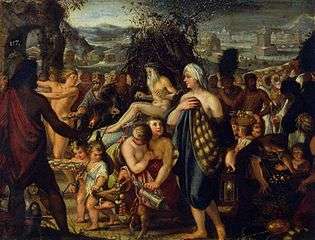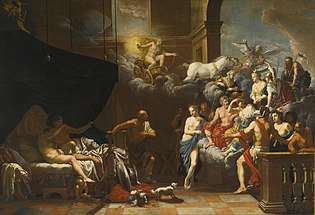Johann Heiss
Johann Heiss, or Heiß (19 June 1640, Memmingen – February 1704, Augsburg) was a German painter in the Baroque style, known for historical, Biblical and mythological scenes.

Life and work
His artistic training took place in Memmingen, under the tutelage of the Sichelbein brothers; Hans Conrad (1581–1669) and Johann (1589–1670). After completing his studies, in 1663, he went to Stuttgart and was in the service of Eberhard III, Duke of Württemberg. In 1675, his works were praised by the art historian Joachim von Sandrart in his book, the Teutsche Academie. After 1677, he lived and worked in Augsburg.[1] While there, he came under the influence of Johann Heinrich Schönfeld.
His works may be seen in museums throughout Germany, as well as at the Louvre, the Kunsthistorisches Museum (Vienna), the Hermitage and the Milwaukee Art Museum.[2]
On site works include altarpieces at the Pilgrimage Church in Grafrath, a cycle on the Crucifixion at the Benedictine monastery in Ochsenhausen and an allegory of Abundantia at the Merkantilmagistrat in Bolzano.
His work "Manus Dei", ironically made famous due to a forgery of it by Wolfgang Beltracchi that was displayed in the Szépművészeti Múzeum, is now considered lost.
References
- Time Line @ the Gedenkdaten der Fuggerstadt Augsburg,
- "Achilles Discovered by Ulysses Among the Daughters of Lycomedes" @ the Milwaukee Art Museum.
Further reading
- Peter Königfeld, Der Maler Johann Heiss. Memmingen und Augsburg 1640–1704, Konrad, 2001 ISBN 3-87437-451-3
- Wolfgang Meighörner, Johann Heiss. Schwäbischer Meister barocker Pracht (exhibition catalog), Robert Gessler, 2002 ISBN 3-86136-077-2. Katalog zur Ausstellung im Zeppelin Museum Friedrichshafen, 18. Oktober 2002 – 9. Februar 2003
- Hanns-Paul Ties: "Die Allegorie der Abundantia mit Flussgöttern im Bozner Merkantilpalast. Ein Meisterwerk des Augsburger Malers Johann Heiss/L'Allegoria dell'Abbondanza con divinità fluviali nel Palazzo Mercantile di Bolzano. Un capolavoro del pittore di Augusta Johann Heiss", in: Leo Andergassen (Ed.): Ulrich Glantschnigg 1661–1722. Der Bozner Barockmaler/Il pittore barocco di Bolzano (Vol.5 of Reihe des Merkantilmuseums Bozen/Quaderno, 2013, pgs. 61–63.
External links
| Wikimedia Commons has media related to Johann Heiss. |
- Literature by and about Johann Heiss in the German National Library catalogue
- More works by Heiss @ ArtNet
